Are you wanting to add some variety in egg colors from your backyard chickens? Are you wondering what type of chickens lay brown eggs? Here is a detailed list of different breeds that lay brown-shelled eggs!
This site contains affiliate links. If you make a purchase using one of these links, I may earn a commission. Please click here for more information about cookies collected and our privacy policy.
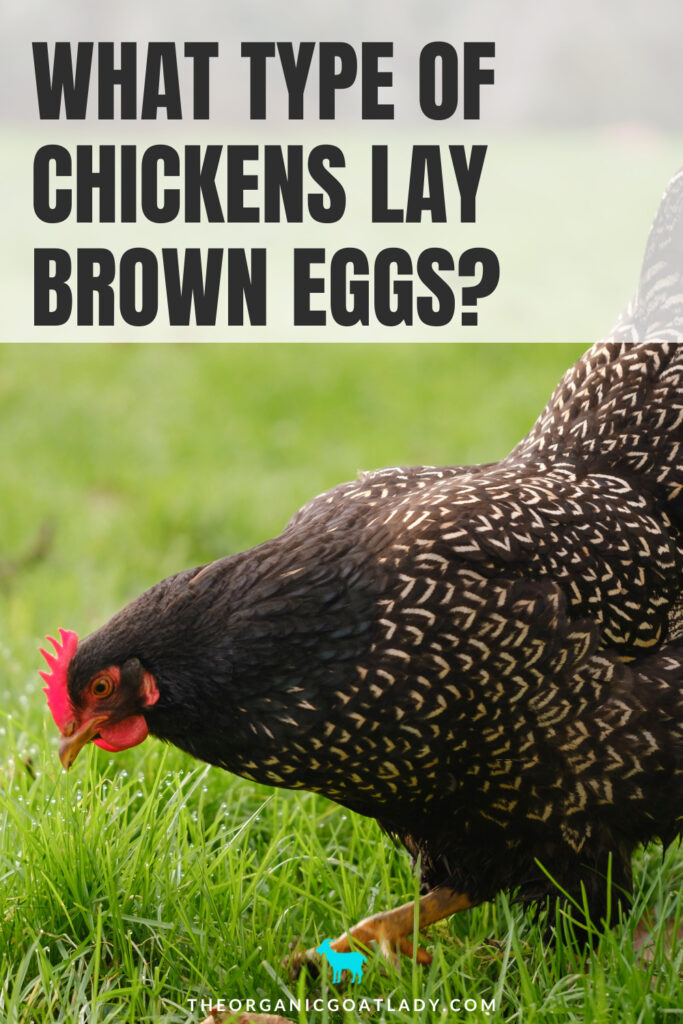
What Type of Chickens Lay Brown Eggs?
Backyard chickens are wonderful to have for many reasons! Number one being the healthy eggs that they can provide for us and our families.
And while egg color isn’t that important, it does make backyard chickens a little more fun and exciting!
Who knew that eggs could come in a variety of colors? White eggs are not the only option!
Various colors of fresh eggs range from blue chicken eggs to green eggs and from pink eggs to chocolate-colored eggs!
Today we are going to focus on the breeds that lay eggs that are brown.
Brown chicken eggs can range from light brown eggs to deep chocolate brown eggs.
Why Do Some Chickens Lay Brown Eggs?
The color of a chicken’s eggshell is determined by the genetics of the breed. The pigment responsible for the brown coloration is called protoporphyrin. Chickens that lay brown eggs have a higher concentration of protoporphyrin deposited on the surface of the eggshell during its formation in the hen’s oviduct.
Brown egg-laying breeds have a specific genetic trait that leads to the production of brown pigments in the shell gland of the hen’s reproductive system. The brown pigment is then incorporated into the eggshell as the egg is formed. The amount and shade of brown can vary among individual chickens and even among different eggs laid by the same chicken.
It’s important to note that the color of the eggshell doesn’t affect the taste or nutritional value of the egg. The difference in eggshell color is mainly a result of the breed’s genetics and has no impact on the quality of the egg inside.
Which Chicken Breeds Lay Brown Eggs?
Multiple chicken breeds are known for laying brown eggs. Some of these breeds include:
Rhode Island Red
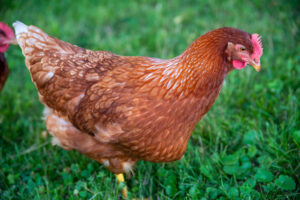
Rhode Island Red chickens are a popular breed known for their excellent egg-laying capabilities and versatile nature. Here are some key characteristics and information about Rhode Island Reds:
1. Egg Production: Rhode Island Reds are prolific brown egg layers. They are known for consistently laying a large number of medium to large brown eggs. They typically start laying eggs around 5 to 6 months of age.
2. Appearance: These chickens have deep, rich red feathers with some black accents in their tails. They have a single red comb and wattles, and their eyes are usually reddish-brown. There are both production and exhibition strains of Rhode Island Reds, with the former focusing more on egg production and the latter on breed standards for shows.
3. Temperament: Rhode Island Reds are generally calm, friendly, and easy to handle. They can adapt well to different environments, making them suitable for backyard flocks.
4. Hardiness: This breed is known for its hardiness and ability to withstand various climates. They have good cold and heat tolerance.
5. Dual Purpose: While they are primarily known for their egg-laying abilities, Rhode Island Reds are also considered a dual-purpose breed, meaning they can be raised for both egg production and meat.
6. Size: Rhode Island Reds are medium to large-sized birds. Roosters (males) can weigh around 8.5 pounds (3.9 kg), and hens (females) can weigh around 6.5 pounds (2.9 kg).
7. Broodiness: While the modern production strains of Rhode Island Reds tend to be less broody (sitting on eggs to hatch them), some individual hens might still exhibit broody behavior.
8. History: The Rhode Island Red breed was developed in the late 19th century in the United States, specifically in the state of Rhode Island. They were bred from various chicken breeds, including Malays, Cochins, and Red Junglefowl, with the goal of creating a hardy and productive dual-purpose chicken.
9. Varieties: There are different varieties of Rhode Island Reds, including the standard deep red color, as well as lighter variations like the “Production Red,” which is often used for commercial egg production.
Overall, Rhode Island Red chickens are a great choice for backyard chicken keepers who are looking for a reliable and friendly breed that produces abundant brown eggs while also being capable of serving as meat birds if desired.
Plymouth Rock (Barred Rock)
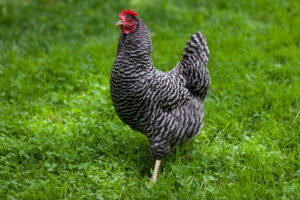
Plymouth Rock, commonly known as Barred Rock, is another popular chicken breed with distinct characteristics. Here’s some information about Plymouth Rock (Barred Rock) chickens:
1. Egg Production: Barred Rocks are known for their good egg-laying abilities. They typically lay brown eggs, and while they might not be as prolific as some other breeds, they still provide a steady supply of eggs.
2. Appearance: Barred Rocks have a distinctive black-and-white barred feather pattern. Their feathers are predominantly black with white barring across the body. They have a single red comb and wattles, and their legs are yellow.
3. Temperament: Barred Rocks are known for their docile and friendly personalities. They are often described as calm and easy to handle, making them suitable for backyard flocks and families.
4. Dual Purpose: Like Rhode Island Reds, Barred Rocks are considered a dual-purpose breed. They are valued not only for their egg-laying capabilities but also for their meat quality. They have a decent growth rate and produce a good-sized carcass.
5. Hardiness: Barred Rocks are hardy and can adapt well to various climates. They are able to tolerate both cold and hot conditions.
6. Size: These chickens are medium to large in size. Roosters can weigh around 9.5 pounds (4.3 kg), and hens can weigh around 7.5 pounds (3.4 kg).
7. Broodiness: Some Barred Rock hens can be prone to broodiness, which means they may go through periods where they want to sit on eggs and hatch them. This behavior can be managed if you’re not interested in raising chicks.
8. History: The Plymouth Rock breed was developed in the United States in the 19th century. It was created through the crossbreeding of various chicken breeds, including Dominiques, Cochins, and Black Javas.
9. Varieties: While the Barred Rock variety is perhaps the most well-known, there are other varieties of Plymouth Rocks as well, such as White Rock, Buff Rock, and more. Each variety has its own distinct feather coloration.
Barred Rock chickens are a popular choice for backyard flocks due to their gentle nature, ability to adapt to different environments, and the combination of egg production and meat quality they offer. Whether you’re interested in raising chickens for eggs, meat, or both, Barred Rocks can be a valuable addition to your flock.
Sussex (various color varieties)
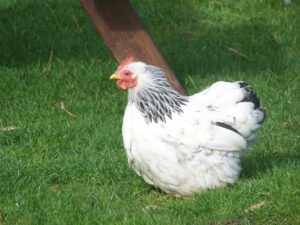
Sussex chickens are a versatile and attractive breed known for their friendly demeanor and egg-laying abilities. They come in various color varieties, each with its own unique characteristics. Here’s an overview of Sussex chickens and their different color variations:
1. Egg Production: Sussex chickens are good egg layers, known for producing a respectable number of brown eggs. Their egg-laying capabilities can vary slightly depending on the specific color variety.
2. Appearance: Sussex chickens are medium to large-sized birds with a distinctive appearance. They have a rounded body shape, a single red comb, wattles, and bright red earlobes. Sussex chickens also have clean legs and a well-rounded, plump appearance.
3. Temperament: Sussex chickens are renowned for their friendly and calm personalities. They are typically easy to handle, making them suitable for backyard flocks and environments with children.
4. Varieties: Sussex chickens come in various color patterns, each with its own name and characteristics. Some of the common Sussex color varieties include:
– Light Sussex: White feathers with black neck and tail feathers. They have a classic and striking appearance.
– Speckled Sussex: Their feathers are a rich, reddish-brown color with white speckles. They have a rustic and attractive appearance.
– Red Sussex: A solid reddish-brown color with a slightly lighter undercolor. They are often chosen for their warm and beautiful plumage.
– Buff Sussex: A soft, golden-buff color all over. Buff Sussex chickens have a warm and inviting appearance.
– Silver Sussex: Silver feathers with a distinct lacing pattern, giving them a unique and elegant look.
5. Hardiness: Sussex chickens are known for their hardiness and adaptability to different climates. They can handle both cold and hot conditions relatively well.
6. Size: The size of Sussex chickens varies by variety, but they generally fall within the medium to large range. Roosters can weigh around 8.5 pounds (3.9 kg), and hens can weigh around 6.5 pounds (2.9 kg).
7. Broodiness: Some Sussex hens can exhibit broody behavior, which means they may want to sit on eggs and hatch them. This can be managed based on your preferences and flock management goals.
8. History: Sussex chickens have a long history that dates back several centuries in the Sussex region of England. They were originally bred as utility birds, valued for both their egg production and meat quality.
Overall, Sussex chickens, regardless of their color variety, are known for their combination of good egg production, friendly temperament, and attractive appearance. When selecting a Sussex variety, consider factors such as egg-laying capabilities, plumage color, and your personal preferences.
Orpington (Buff Orpington)
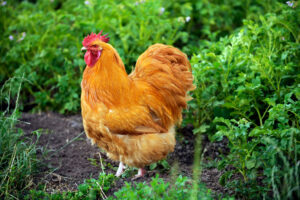
Orpington chickens, specifically the Buff Orpington variety, are well-known for their gentle nature, attractive appearance, and dual-purpose capabilities. Here’s more information about Buff Orpington chickens:
1. Egg Production: Buff Orpingtons are known for their good egg-laying abilities. They produce brown eggs at a relatively steady rate, making them a practical choice for those interested in both eggs and meat.
2. Appearance: Buff Orpingtons are characterized by their soft and fluffy appearance. They have a rich, golden-buff color of feathers that gives them a warm and inviting look. Their feathers are loose and fluffy, which adds to their overall charm.
3. Temperament: One of the standout qualities of Buff Orpington chickens is their friendly and docile nature. They are often described as calm, gentle, and affectionate birds that are easy to handle. This temperament makes them a favorite among backyard chicken keepers.
4. Dual Purpose: Buff Orpingtons are considered a dual-purpose breed. They are valued not only for their egg production but also for their meat quality. Their plump bodies and relatively quick growth rate make them suitable for both roles.
5. Hardiness: While Buff Orpingtons have a lot of feathers, they are still relatively cold-hardy and can adapt well to various climates. However, their fluffy feathers might make them more prone to heat stress in extremely hot weather.
6. Size: Buff Orpingtons are medium to large-sized chickens. Roosters can weigh around 10 pounds (4.5 kg), and hens can weigh around 8 pounds (3.6 kg).
7. Broodiness: Buff Orpington hens have a tendency to be broody. They may want to sit on eggs and hatch them. This can be managed based on your breeding goals and flock management preferences.
8. History: The Orpington breed was developed in England in the late 19th century by William Cook. He aimed to create a breed that was both attractive and practical. The Buff variety was one of the original color variations of the breed.
9. Other Varieties: In addition to Buff Orpingtons, there are other color varieties of Orpington chickens, including Black, Blue, White, and more. Each variety has its own unique feather color and appearance.
Buff Orpington chickens are a wonderful choice for backyard flocks, especially for those who value a friendly temperament, beautiful appearance, and the benefits of both egg and meat production. Their gentle nature and lovely golden-buff feathers make them a favorite among chicken enthusiasts.
Marans
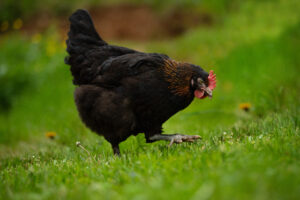
Marans chickens are a unique and sought-after breed known for their beautiful dark brown eggs and distinctive appearance. Here’s more information about Marans chickens:
1. Egg Production: Marans are famous for laying dark brown eggs that often have a rich chocolate-colored hue. Their egg color is one of their most notable characteristics and is highly valued by egg enthusiasts. Egg color can vary slightly among individual Marans.
2. Appearance: Marans chickens have a wide range of color variations and patterns. They are often characterized by their feathered legs and feet, which is a trait not common in all chicken breeds. Their feather colors can include black copper, cuckoo (white and black striped), blue copper, splash, and more.
3. Temperament: Marans chickens typically have calm and docile personalities. While individual temperaments can vary, Marans are often known for being friendly and well-suited for backyard environments.
4. Hardiness: Marans are hardy birds that can adapt to various climates. However, their feathered legs and feet might make them more susceptible to certain environmental conditions, so proper care is important.
5. Egg Color and Quality: The dark brown eggs laid by Marans are a result of the breed’s genetics. The eggshell color is due to a pigment called protoporphyrin. The intensity of the egg color can vary, with some Marans laying eggs that are darker than others.
6. Size: Marans are medium-sized birds. Roosters typically weigh around 7.5 pounds (3.4 kg), and hens can weigh around 6.5 pounds (2.9 kg).
7. Broodiness: Some Marans hens can be prone to broodiness, showing a desire to sit on eggs and hatch them. This behavior can be managed based on your flock management goals.
8. History: Marans chickens originated in France and were named after the Marans town in the country. They were developed by crossbreeding various local and imported chicken breeds to improve their egg-laying qualities and hardiness.
9. Varieties: Marans come in various color variations, and each variety has its own distinct appearance and egg color. Black Copper Marans, which have black feathers with copper accents, are among the most popular color varieties.
Marans chickens are particularly favored by those who appreciate their unique egg color and desire a breed that is both visually striking and productive. If you’re interested in having dark brown eggs in your flock and appreciate the charm of feathered legs, Marans could be a great addition to your backyard.
Welsummer
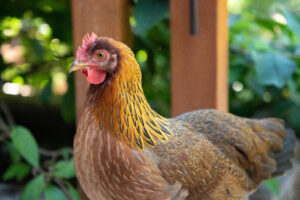
Welsummer chickens are known for their distinct appearance, rustic charm, and their ability to produce beautiful dark brown eggs. Here’s more information about Welsummer chickens:
1. Egg Production: Welsummers are renowned for their dark brown eggs with rich terracotta or reddish-brown hues. Their egg color is a major attraction for backyard chicken keepers and those who appreciate unique egg colors.
2. Appearance: Welsummer chickens have a rustic and eye-catching appearance. They have a striking pattern on their feathers, with rich reddish-brown feathers adorned with black “partridge” markings that resemble a speckled pattern. Their feathers give them a wild and natural look.
3. Temperament: Welsummers are often described as friendly and calm birds. They tend to be fairly docile and can be good additions to backyard flocks, particularly if you’re looking for approachable and well-behaved chickens.
4. Hardiness: Welsummers are hardy and can adapt well to various climates. They are known for their robust nature, making them well-suited for outdoor living.
5. Egg Color and Quality: The eggs laid by Welsummers are their standout feature. The eggs are often described as having a terracotta or reddish-brown color. The egg color can vary somewhat among individual birds, but it’s generally a key characteristic of the breed.
6. Size: Welsummers are medium-sized birds. Roosters typically weigh around 7.5 pounds (3.4 kg), and hens can weigh around 6.5 pounds (2.9 kg).
7. Broodiness: Welsummer hens can exhibit broodiness, meaning they may want to sit on eggs and hatch them. This can be managed based on your flock management goals.
8. History: Welsummer chickens originated in the Netherlands, specifically in the village of Welsum. They were developed from local Dutch chickens and various other breeds, resulting in their distinctive appearance and egg-laying qualities.
9. Varieties: While the classic Welsummer appearance features partridge coloring (reddish-brown with black markings), there are also silver and gold varieties of Welsummers with different feather colors and patterns.
Welsummer chickens are a favorite among those who value unique egg colors and enjoy the charm of their rustic appearance. If you’re looking for a breed that combines attractive aesthetics with good egg production and friendly personalities, Welsummers could be an excellent choice for your flock.
Australorp
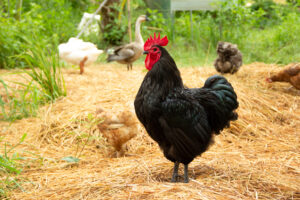
Australorp chickens, short for Australian Orpington, are a breed known for their exceptional egg-laying abilities, friendly demeanor, and sleek appearance. Here’s more information about Australorp chickens:
1. Egg Production: Australorps are renowned for their excellent egg-laying capabilities. They are known to be highly productive layers of large brown eggs. In fact, Australorps have set world records for egg production, making them a top choice for egg enthusiasts and small farmers.
2. Appearance: Australorps have a sleek and shiny appearance. Their feathers are typically black and have a beautiful greenish sheen in the sunlight. They have a single red comb and wattles, and their legs are typically black.
3. Temperament: Australorps are known for their friendly and calm personalities. They are generally easy to handle and can be quite gentle, making them a good fit for families and beginner chicken keepers.
4. Hardiness: Australorps are hardy birds that can adapt well to different climates. Their black feathers might make them more prone to heat in extremely hot weather, so providing proper shade and cooling options is important.
5. Size: Australorps are medium to large-sized chickens. Roosters typically weigh around 8.5 pounds (3.9 kg), and hens can weigh around 6.5 pounds (2.9 kg).
6. Broodiness: While some individual Australorp hens might go broody, they are generally less prone to broodiness compared to some other breeds.
7. History: Australorps were developed in Australia in the early 20th century through the crossbreeding of Orpington chickens and other breeds. The goal was to create a breed that excelled in egg production and meat quality.
8. Varieties: While black is the most common color variety, there are also blue and white Australorps, although they are less common. The black variety is the one most people associate with the breed.
Australorp chickens are highly regarded for their egg-laying prowess, gentle nature, and attractive appearance. If you’re looking for a breed that will provide a consistent supply of eggs and also be a friendly addition to your flock, Australorps are certainly worth considering.
New Hampshire Red
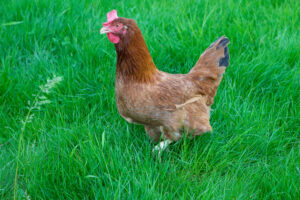
New Hampshire Red chickens are a breed known for their dual-purpose capabilities, hardiness, and vibrant reddish-brown feathers. Here’s more information about New Hampshire Red chickens:
1. Egg Production: New Hampshire Reds are known for their decent egg-laying abilities. They typically produce brown eggs, though they might not be as prolific as some specialized egg-laying breeds.
2. Appearance: New Hampshire Reds have a striking appearance with rich reddish-brown feathers. They have a single red comb and wattles, and their legs are yellow. Their appearance is similar to the Rhode Island Red, although New Hampshire Reds tend to have a lighter and more vibrant shade of red.
3. Temperament: New Hampshire Reds are generally known for their calm and docile personalities. They are often well-behaved and easy to handle, making them suitable for backyard flocks and families.
4. Dual Purpose: New Hampshire Reds are valued for both their egg-laying abilities and meat quality. They grow relatively quickly and have good meat characteristics, making them suitable for those interested in raising chickens for meat as well as eggs.
5. Hardiness: New Hampshire Reds are hardy and can adapt well to different climates. Their feathers provide good insulation, which helps them cope with various weather conditions.
6. Size: New Hampshire Reds are medium to large-sized birds. Roosters can weigh around 8.5 pounds (3.9 kg), and hens can weigh around 6.5 pounds (2.9 kg).
7. Broodiness: New Hampshire Reds, like many dual-purpose breeds, can occasionally exhibit broody behavior, wanting to sit on eggs and hatch them. This can be managed based on your flock management goals.
8. History: The New Hampshire Red breed was developed in the United States in the early 20th century. It was created as an improvement of the Rhode Island Red breed, aiming to enhance both its meat and egg-laying qualities.
New Hampshire Red chickens are a practical choice for those who are looking for a dual-purpose breed that provides a combination of eggs and meat. Their hardiness, attractive appearance, and friendly temperament make them a valuable addition to many backyard flocks.
Dominique
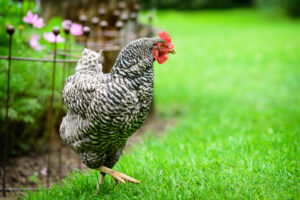
Dominique chickens, often referred to as Dominickers or Pilgrim Fowl, are an American heritage breed known for their historical significance, hardiness, and distinctive black-and-white striped feather pattern. Here’s more information about Dominique chickens:
1. Historical Significance: Dominiques are considered one of the oldest chicken breeds in the United States. They have a long history dating back to colonial times and were one of the first American breeds to be developed.
2. Feather Pattern: Dominique chickens have a unique feather pattern called “rose comb.” They are primarily black with white barring across their feathers, giving them a striped or barred appearance. The feather pattern provides good camouflage and protection from predators.
3. Egg Production: Dominiques are decent egg layers, known for producing brown eggs. While they might not be as prolific as some modern breeds, they still provide a steady supply of eggs.
4. Temperament: Dominiques are often described as friendly, docile, and active. They can be good foragers and adapt well to free-range environments.
5. Hardiness: One of the notable qualities of Dominiques is their hardiness. They can handle various weather conditions and are known for being reliable and low-maintenance birds.
6. Size: Dominiques are medium-sized birds. Roosters can weigh around 7.5 pounds (3.4 kg), and hens can weigh around 6.5 pounds (2.9 kg).
7. Broodiness: Dominiques are known to have a tendency toward broodiness, meaning they might want to sit on eggs and hatch them. This behavior can be managed based on your flock management goals.
8. Varieties: While the classic color pattern is black with white barring, there is also a variety called “Blue Dominique,” which has blue feathers with lighter blue barring.
9. History: Dominiques have a rich history in the United States. They were popular among early American settlers and were valued for their ability to thrive in a wide range of environments.
Dominique chickens are a wonderful choice for those interested in preserving heritage breeds and historical significance. Their unique appearance, hardiness, and friendly temperament make them an attractive addition to backyard flocks, especially for enthusiasts interested in maintaining traditional breeds.
Java
Java chickens, also known as American Javas, are another historic American breed with distinct characteristics. Here’s more information about Java chickens:
1. Historical Significance: Javas are one of the oldest chicken breeds developed in the United States. They have a long history dating back to the early 19th century and were among the first breeds to be established in the country.
2. Appearance: Javas are known for their striking appearance and unique color varieties. They are available in both Black and Mottled varieties. The Black Java has glossy black feathers, while the Mottled Java has a mottled black and white pattern.
3. Egg Production: Javas are dual-purpose birds that were historically valued for both meat and egg production. They are moderate egg layers, producing brown eggs. While they might not lay as many eggs as some modern breeds, they contribute to a sustainable and self-sufficient flock.
4. Temperament: Javas are often described as calm, docile, and friendly. They can make good additions to backyard flocks and are generally easy to handle.
5. Hardiness: Javas are known for their hardiness and adaptability to various climates. They were developed to withstand the challenges of early American agriculture and have a reputation for being robust birds.
6. Size: Javas are medium to large-sized birds. Roosters can weigh around 9.5 pounds (4.3 kg), and hens can weigh around 7.5 pounds (3.4 kg).
7. Broodiness: Javas have a tendency to be broody, meaning they may want to sit on eggs and hatch them. This broodiness can be managed based on your flock management goals.
8. Varieties: Javas are primarily available in two varieties: Black Java and Mottled Java. Each variety has its own unique appearance and historical significance.
9. History: Javas were developed in the United States during the early 19th century. They were originally bred from chickens brought to America from Java, Indonesia, hence their name.
Java chickens are a great choice for those interested in preserving historical American breeds and appreciating their contributions to the country’s agricultural heritage. Their unique appearance, calm temperament, and dual-purpose qualities make them a valuable addition to flocks focused on sustainability and tradition.
Additional Lesser Known Chickens That Lay Brown Eggs
Below are some lesser known chicken varieties. They also lay brown eggs.
Barnevelder
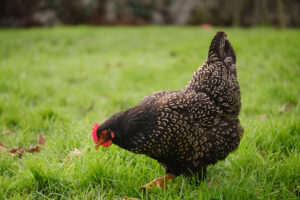
Barnevelder chickens are a Dutch breed known for their striking appearance, good egg-laying abilities, and friendly temperament. Here’s more information about Barnevelder chickens:
1. Appearance: Barnevelders are known for their unique and attractive feather patterns. They have a double-laced feather pattern, which means their feathers have a dark outer edge with a lighter inner lacing. This gives them a beautiful and intricate appearance. Barnevelders come in a variety of colors, with the most common being the double-laced variety.
2. Egg Production: Barnevelders are known for their moderate egg-laying capabilities. They typically produce brown eggs. While they might not be as prolific as some modern egg-laying breeds, their egg production is still respectable.
3. Temperament: Barnevelders are often described as friendly, calm, and docile. They are generally easy to handle and can make good additions to family flocks.
4. Hardiness: Barnevelders are known for their hardiness and adaptability to different environments. They can handle various weather conditions and are often valued for their resilience.
5. Size: Barnevelders are medium-sized birds. Roosters can weigh around 7.5 pounds (3.4 kg), and hens can weigh around 6.5 pounds (2.9 kg).
6. Broodiness: Barnevelder hens have a tendency to go broody, meaning they may want to sit on eggs and hatch them. This broodiness can be managed based on your flock management goals.
7. Varieties: Barnevelders come in different color varieties, including the aforementioned double-laced variety as well as other colors like silver and gold.
8. History: Barnevelder chickens were developed in the Netherlands, specifically in the town of Barneveld. They were bred from a variety of chickens, including local Dutch chickens and Asian breeds, to create a practical and attractive dual-purpose breed.
Barnevelder chickens are a great choice for those who appreciate unique feather patterns and historical breeds. Their attractive appearance, combined with their friendly temperament and moderate egg-laying capabilities, make them a valuable addition to backyard flocks.
Cuckoo Marans
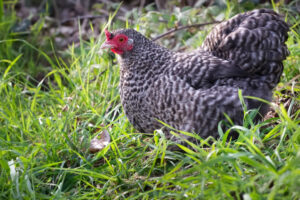
Cuckoo Marans chickens are a variety of the Marans breed known for their distinctive feather pattern and their ability to lay dark brown eggs. Here’s more information about Cuckoo Marans chickens:
1. Cuckoo Feather Pattern: Cuckoo Marans have a unique feather pattern called “cuckoo” or “barred.” This pattern is characterized by alternating bands of light and dark color across the feathers, creating a striped appearance. The feather pattern helps provide camouflage and protection from predators.
2. Egg Production: Cuckoo Marans are valued for their ability to lay dark brown eggs. While their egg production might not be as high as some specialized egg-laying breeds, their eggs are highly sought after for their deep brown color.
3. Temperament: Cuckoo Marans are often described as friendly, calm, and docile. They can make good additions to backyard flocks and are generally easy to handle.
4. Hardiness: Like other Marans varieties, Cuckoo Marans are known for their hardiness and adaptability to various climates. They can handle different weather conditions well.
5. Size: Cuckoo Marans are medium-sized birds. Roosters can weigh around 7.5 pounds (3.4 kg), and hens can weigh around 6.5 pounds (2.9 kg).
6. Broodiness: Cuckoo Marans hens can occasionally exhibit broody behavior, meaning they may want to sit on eggs and hatch them. This behavior can be managed based on your flock management goals.
7. History: Marans chickens, including the Cuckoo variety, originated in France. They were developed from local French chickens and other breeds to create a breed known for its egg-laying abilities and distinctive feather patterns.
8. Varieties: In addition to Cuckoo Marans, there are other color varieties of Marans, such as Black Copper Marans, which have a black feather base with copper accents.
Cuckoo Marans chickens are a great choice for those who appreciate unique feather patterns and are interested in obtaining dark brown eggs. Their attractive appearance, combined with their friendly temperament and egg-laying capabilities, make them a valuable addition to backyard flocks and those seeking eggs with a special color.
Red Star (also known as ISA Brown or Red Sex Link)
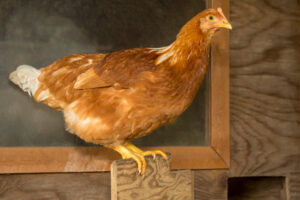
Red Star, also known as ISA Brown or Red Sex Link, is a hybrid chicken breed specifically developed for its exceptional egg-laying abilities. Here’s more information about Red Star chickens:
1. Hybrid Breed: Red Star is a hybrid breed created by crossing specific parent breeds with known egg-laying traits. These parent breeds are selected for their egg production potential, and the resulting hybrid chickens inherit the best qualities from both parent breeds.
2. Egg Production: Red Star chickens are renowned for their outstanding egg-laying capabilities. They are bred to be highly prolific layers of large brown eggs. Red Stars are often chosen by commercial egg producers due to their reliable and consistent egg production.
3. Appearance: Red Stars usually have a distinctive appearance. They often have reddish-brown feathers, although the exact color can vary. Their feathers might appear slightly lighter or darker depending on the individual bird.
4. Temperament: Red Star chickens are generally friendly and docile. They tend to have good dispositions, which makes them suitable for backyard flocks and various environments.
5. Hybrid Vigor: One of the advantages of hybrid breeds like the Red Star is their hybrid vigor or heterosis. This means they inherit enhanced traits from their parent breeds, often resulting in improved health, growth, and egg production.
6. Hardiness: While they are bred for egg production, Red Star chickens are generally hardy and can adapt well to different climates. However, their focus on egg production might make them slightly less resilient compared to some traditional breeds.
7. Size: Red Star chickens are medium-sized birds. Roosters can weigh around 7.5 pounds (3.4 kg), and hens can weigh around 6.5 pounds (2.9 kg).
8. Varieties: Red Stars are not a breed recognized by the American Poultry Association (APA), but rather a name often used for specific commercial or hybrid strains developed for egg production.
Red Star (ISA Brown) chickens are an excellent choice for those primarily interested in maximizing egg production. Their consistent egg-laying abilities, friendly temperament, and hybrid vigor make them a popular option for backyard flocks and small-scale egg production operations.
Black Star (also known as Black Sex Link)
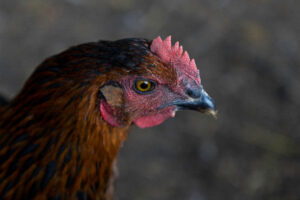
Black Star, also known as Black Sex Link, is another hybrid chicken breed that is bred for its specific characteristics and attributes. Here’s more information about Black Star chickens:
1. Hybrid Breed: Black Star is a hybrid breed created by crossbreeding specific parent breeds with distinct traits. This hybridization results in chickens that inherit the best qualities of their parent breeds, particularly in terms of egg production and meat quality.
2. Egg Production: Black Star chickens are bred primarily for their excellent egg-laying capabilities. They are known for being prolific layers of large brown eggs. Like other sex-linked hybrids, their gender can be easily determined by their coloration as chicks.
3. Appearance: Black Star chickens typically have distinctive appearances. They are often black with gold or red feathers on their neck and chest. The color variations can vary, but the contrast between the black and the contrasting color is a key characteristic.
4. Temperament: Black Star chickens generally have calm and friendly temperaments. They are well-suited for backyard flocks, and their docile nature makes them easy to handle.
5. Hybrid Vigor: Like other hybrid breeds, Black Stars exhibit hybrid vigor, which means they benefit from improved health, growth, and production due to the genetic diversity from their parent breeds.
6. Hardiness: While Black Star chickens are bred for their specific qualities, they are generally hardy and adaptable to various climates. However, their focus on egg production might make them slightly less resilient compared to some traditional breeds.
7. Size: Black Star chickens are medium-sized birds. Roosters can weigh around 7.5 pounds (3.4 kg), and hens can weigh around 6.5 pounds (2.9 kg).
8. Varieties: Black Stars are not a recognized breed by poultry associations but are often used as names for specific commercial hybrid strains. They are also referred to as Black Sex Links due to the distinct appearance of male and female chicks.
Black Star (Black Sex Link) chickens are popular among small-scale poultry keepers who are looking for consistent egg production and a docile temperament. Their ability to produce a large number of eggs while also being easy to manage makes them a favored choice for backyard flocks and small egg-producing operations.
Golden Comet
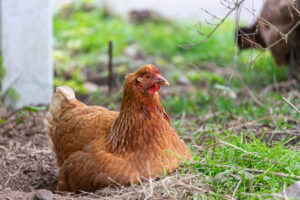
Golden Comet is a hybrid chicken breed known for its exceptional egg-laying abilities, friendly demeanor, and overall suitability for backyard flocks. Here’s more information about Golden Comet chickens:
1. Hybrid Breed: Golden Comet is a hybrid breed created by crossbreeding specific parent breeds with desirable egg-laying traits. This hybridization results in chickens that excel in egg production while maintaining other desirable qualities.
2. Egg Production: Golden Comet chickens are highly regarded for their outstanding egg-laying capabilities. They are known as prolific layers of large brown eggs. This breed’s primary purpose is egg production, and they are bred to consistently lay a high number of eggs.
3. Appearance: Golden Comets typically have a golden or reddish-brown feather color, which contributes to their name. They are usually well-feathered and have a neat and attractive appearance.
4. Temperament: Golden Comet chickens are known for their friendly and docile personalities. They tend to be calm and easy to handle, making them a great choice for families and beginners.
5. Hybrid Vigor: Like other hybrid breeds, Golden Comets benefit from hybrid vigor or heterosis. This results in improved health, growth, and production due to the genetic diversity from their parent breeds.
6. Hardiness: Golden Comet chickens are generally hardy and can adapt well to various climates. Their focus on egg production might make them slightly less resilient compared to some traditional breeds, but they are still well-suited for backyard environments.
7. Size: Golden Comet chickens are medium-sized birds. Roosters can weigh around 7.5 pounds (3.4 kg), and hens can weigh around 6.5 pounds (2.9 kg).
8. Varieties: Golden Comet is a specific hybrid strain, and its characteristics are consistent within the strain. However, there might be minor variations in feather coloration.
Golden Comet chickens are a popular choice for those looking to have a consistent supply of eggs from their backyard flock. Their excellent egg-laying capabilities, friendly temperament, and manageable size make them a favorite among small-scale poultry keepers and families.
Remember that the eggshell color can still vary within these breeds due to factors like genetics, diet, and living conditions. If you’re specifically looking for brown egg layers, these breeds are good choices to consider.
Click the below links to find more important info regarding raising backyard chickens:
How to Kill Parasites in Chickens Using Essential Oils

